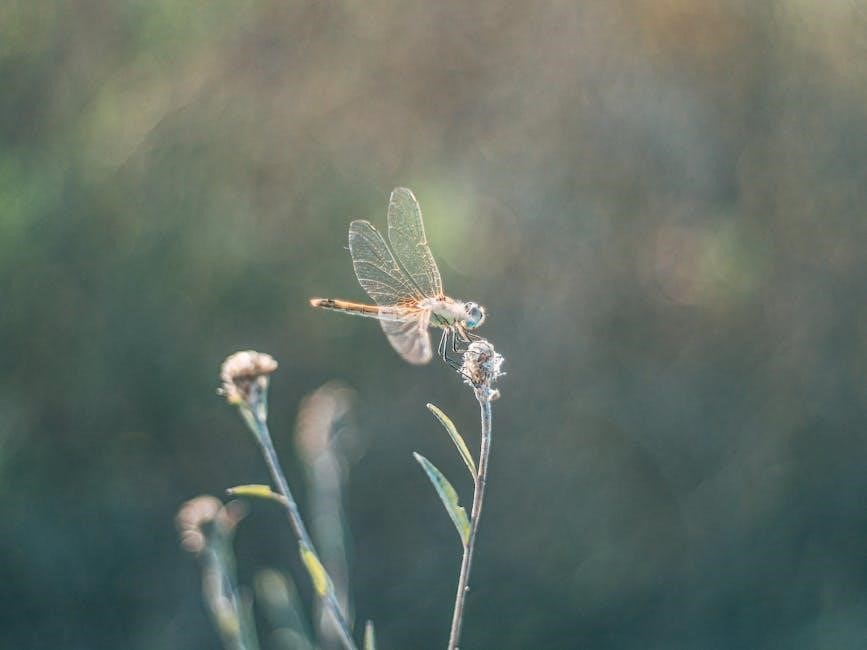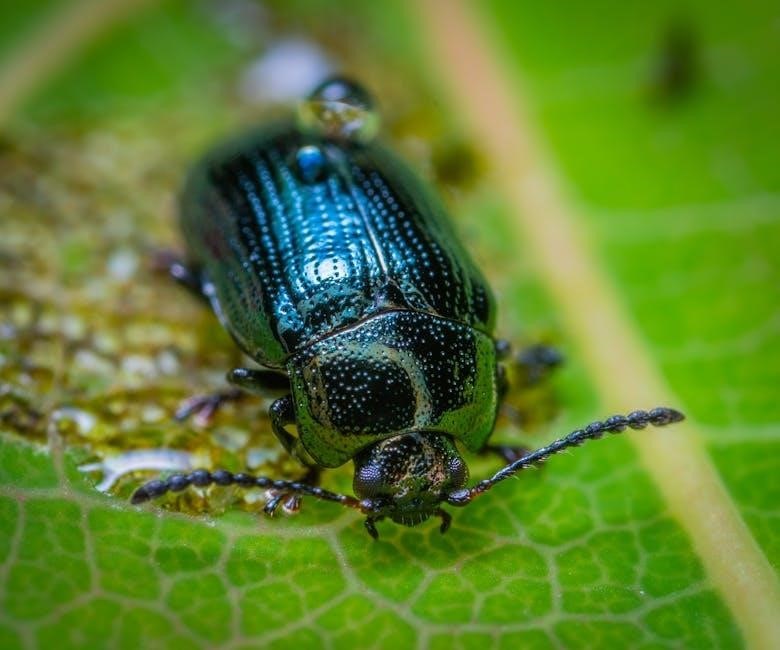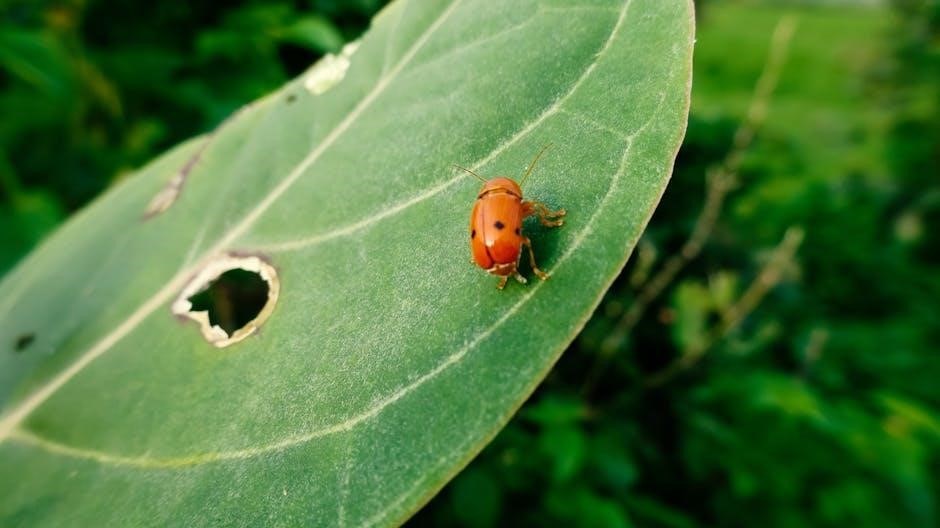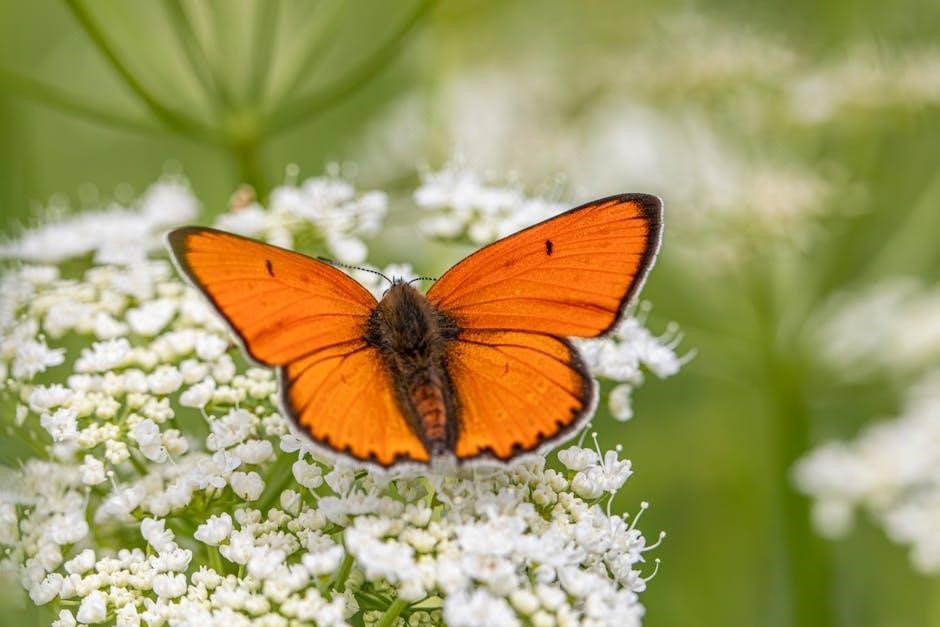Discover the world of insects with comprehensive field guides featuring detailed descriptions and photos‚ perfect for beginners and experts‚ using online resources and publications effectively always.
Overview of Available Guides
There are numerous insect field guides available‚ each with its own unique features and strengths. Some guides‚ such as the Kaufman Field Guide to Butterflies of North America‚ specialize in specific types of insects‚ while others‚ like the National Wildlife Federation field guide‚ provide a more comprehensive overview of insects in general. These guides often include detailed descriptions‚ photographs‚ and identification keys to help users accurately identify the insects they encounter. Many guides are also tailored to specific regions‚ making it easier for users to find information relevant to their area. Overall‚ the variety of available guides ensures that users can find a resource that meets their needs and interests‚ whether they are beginners or experienced entomologists. The guides are widely available in bookstores and online‚ making it easy to get started with insect identification.
Comprehensive Field Guides
Guides provide detailed information and photos of various insect species and families always using online resources effectively.
National Wildlife Federation Field Guide
The National Wildlife Federation field guide is a comprehensive resource for identifying insects‚ featuring detailed descriptions and photographs of various species. This guide is part of a series that also includes field guides for birds‚ trees‚ and wildflowers. The guide provides information on the biology and life histories of insects‚ making it a valuable tool for both beginners and experts. With its beautiful photography and easy-to-use format‚ this guide enables users to quickly and accurately identify insects. The guide also features a comprehensive introduction that discusses classification and nomenclature‚ as well as the latest research on insect diversity and global threats. Overall‚ the National Wildlife Federation field guide is an essential resource for anyone interested in learning about insects and their importance in the natural world. It is a valuable addition to any library or field kit.
Insect Identification
Using field guides and online resources to identify insects is essential for understanding their biology and ecology effectively always with accurate information and photos.
Family Identification
Family identification is a crucial step in understanding the diversity of insects‚ with over 783 families recognized in North America‚ each with unique characteristics and features.
The process of family identification involves observing the insect’s morphology‚ behavior‚ and habitat‚ and using this information to narrow down the possible families.
Online resources and field guides‚ such as the Kaufman Field Guide to Insects‚ provide detailed descriptions and photos of each family‚ making it easier to identify the insects.
By understanding the different families of insects‚ enthusiasts and researchers can better appreciate the complexity and diversity of the insect world‚ and gain a deeper understanding of their biology and ecology.
This knowledge can also be used to inform conservation efforts and promote a greater appreciation for the natural world‚ and the importance of insect conservation.
Classification and Nomenclature
Insect classification and nomenclature involve the organization and naming of insects into a hierarchical system‚ with each level representing a more specific group.
This system allows for the identification and differentiation of various insect species‚ and provides a common language for communication among entomologists and researchers.
The classification system is based on the insect’s morphology‚ behavior‚ and evolutionary history‚ and is constantly being refined and updated as new information becomes available.
Online resources and field guides‚ such as the National Wildlife Federation field guide‚ provide detailed information on the classification and nomenclature of insects‚ making it easier for enthusiasts and researchers to understand and navigate the complex world of insects.
The use of standardized classification and nomenclature systems is essential for effective communication and collaboration among insect enthusiasts and researchers‚ and for advancing our understanding of the insect world.

Regional Field Guides
Regional guides provide specific information on local insects‚ using online resources and publications to identify species effectively always in different areas and locations every day.
Utah Insect Identification
Utah insect identification can be done using various field guides and online resources‚ such as the Bug Of Utah log book‚ which helps enthusiasts record and observe insect information.
The log book is designed for both kids and adults‚ making it a great tool for families and entomologists to learn about insects together.
With its comprehensive format‚ users can easily track and identify different insect species found in Utah‚ creating a valuable record of their discoveries.
The guide also provides a space for notes and observations‚ allowing users to deepen their understanding of the insects they encounter.
By using this log book‚ individuals can develop a greater appreciation for the diversity of insects in Utah and contribute to a better understanding of the local ecosystem.
Overall‚ the Bug Of Utah log book is a useful resource for anyone interested in insect identification and exploration in the state of Utah.

Butterfly Identification
Butterfly identification guides provide detailed descriptions and photos for accurate species recognition always using online resources effectively every day.
Butterfly Record Book
A butterfly record book is a valuable tool for enthusiasts‚ providing a space to document and track sightings‚ note habits and habitats‚ and record observations‚ using a systematic approach to organize entries‚ including dates‚ locations‚ and species identified‚ with room for notes and sketches‚ making it an essential companion for fieldwork‚ allowing users to reflect on their experiences and plan future excursions‚ while also contributing to a deeper understanding of these fascinating creatures‚ and their importance in the ecosystem‚ by maintaining a personal record of encounters‚ and using online resources to verify identifications and learn more about the species encountered‚ and the best practices for recording and tracking data‚ and the various methods for organizing and analyzing the information collected.

Using Field Guides
Backyard Insect Identification
To identify insects in your backyard‚ start by observing their behavior and habitat‚ using a field guide to narrow down possibilities‚ and taking note of distinctive features such as color‚ shape‚ and size.
Using online resources and publications can also enhance your learning and exploration‚ providing access to a wealth of information and expert knowledge‚ and helping you to better understand the fascinating world of insects.
By combining observation‚ research‚ and field guide use‚ you can develop your skills and become more confident in identifying the insects that live in and around your backyard‚ and learn more about their life cycles‚ habits‚ and importance in the ecosystem‚ and discover the unique characteristics of each species.
Field Notes Section
The field notes section is a valuable tool for insect enthusiasts‚ providing a space to record observations‚ note habits‚ and track the life cycles of various species.
Using this section‚ you can document your findings‚ sketch the insects you encounter‚ and jot down any relevant information‚ such as the date‚ time‚ and location of sightings.
This section can also be used to compare notes with other field guides‚ helping to refine your identification skills and gain a deeper understanding of the insects you are studying‚ and allowing you to reflect on your experiences and identify areas for further exploration and learning‚ making it an essential component of any insect field guide‚ and a key part of the learning process for anyone interested in entomology.

Insect Diversity
With over one million identified species‚ insects exhibit incredible diversity‚ ranging from tiny fairyflies to large moths‚ and including beetles‚ wasps‚ and flies‚ always found everywhere.
Number of Identified Species
The number of identified insect species is staggering‚ with over one million described species‚ and many more waiting to be discovered and classified by entomologists and researchers using field guides and other resources.
This number represents a significant portion of all known species on Earth‚ and it continues to grow as new species are discovered and described in scientific literature and online databases;
The diversity of insects is a testament to their ability to adapt and thrive in a wide range of environments‚ from the freezing tundra to the hottest deserts‚ and from the deepest oceans to the highest mountains‚ making them a fascinating subject for study and exploration.
The process of identifying and classifying insect species is ongoing‚ and it requires the use of specialized field guides‚ keys‚ and other resources to accurately determine the identity of each species‚ and to learn more about their biology and behavior.